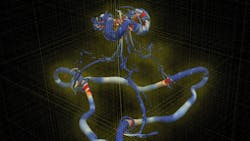Overcoming Turbulence
The last 14 months have helped us redefine the concept of turbulence, but some engineers remember that there is still work to be done on the real definition of turbulence.
As Hydraulics & Pneumatics has reported, turbulence in flight is a constant phenomenon caused by common natural forces—in particular, two counter-rotating vortices trailing behind the aircraft. These vortices can affect other aircraft.
Purdue University researchers have developed a modeling approach that simulates the entire process of a vortex collision in a reduced computational time. The data extracted from the simulation can then be used to help aircraft respond to these events.
“Aircraft in extreme conditions cannot rely on simple modeling,” said Carlo Scalo, a Purdue associate professor of mechanical engineering, in a press release. “Just to troubleshoot some of these calculations can take running them on a thousand processors for a month. You need faster computation to do aircraft design.”
STLE Meeting Opens Today
The Society of Tribologists and Lubrication Engineers (STLE) has started its annual event, converted to a virtual event for this year. The STLE Virtual Annual Meeting & Exhibition to be held Through May 20. STLE will be offering five education courses virtually, before and after the general meeting, so participants can conveniently attend the virtual conference and trade show, and take as many courses as they desire. Click here to view the 2021 education course schedule.
Accidentally on Purpose
Spencer Silver is not a name you’d know at first glance, but he was partially responsible for one of the most successful products in global history. Silver died last week at the age of 80, and if you have to make a note to yourself to look up his biography, you might use one of his creations to do it.
A 3M chemist and researcher, Silver invented the glue that gave us Post-It Notes. Silver’s unique glue composition could be stuck and unstuck repeatedly without harming the surface or losing adhesion. Another 3M colleague, Art Fry, used the glue on a small piece of paper and a product empire was born.
Luck can be defined as when opportunity meets preparation. The ubiquitous Post-It Note was one such moment of luck, but it is inventors such as Silver who toil away on projects great (he had 37 patents in his life) and small, but always keep looking for something new.
About the Author
Bob Vavra
Senior Content Director, Power & Motion and Machine Design
Bob Vavra is the Senior Content Director of Power & Motion and its sister publication Machine Design. Vavra has had a long career in publishing, media and events. He has covered all aspects of manufacturing for the past 20 years and is a regular attendee at events such as IMTS and Hannover Messe. Vavra is also a sought-after webcast moderator and event emcee, and has presided over events in the U.S., Germany and China.

Leaders relevant to this article:
